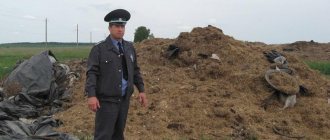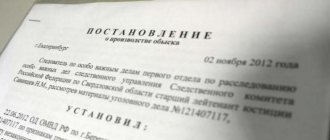ST 254 of the Criminal Code of the Russian Federation.
1. Poisoning, contamination or other damage to land by harmful products of economic or other activities due to violation of the rules for handling fertilizers, plant growth stimulants, pesticides and other dangerous chemical or biological substances during their storage, use and transportation, resulting in harm to human health or the environment - shall be punishable by a fine in the amount of up to two hundred thousand rubles, or in the amount of the wages or other income of the convicted person for a period of up to eighteen months, or by deprivation of the right to hold certain positions or engage in certain activities for a term of up to three years, or by compulsory labor for a term of up to four hundred eighty hours. , or correctional labor for up to two years.
2. The same acts committed in an environmental disaster zone or in an environmental emergency zone are punishable by restriction of freedom for a term of up to two years, or forced labor for a term of up to two years, or imprisonment for the same term.
3. Acts provided for in parts one or two of this article, resulting in the death of a person through negligence, are punishable by forced labor for up to five years or imprisonment for the same term.
Commentary to Art. 254 Criminal Code
1. The subject of the crime is land as a natural object, protected as the most important component of nature, a natural resource used as a means of production in agriculture and forestry and the basis for carrying out economic and other activities on the territory of the Russian Federation, and at the same time as real estate, an object property rights and other rights to land. Related to the term “earth” is the concept of “soil” as a mineral-organic formation, the surface layer of the earth, characterized by fertility.
2. The objective side of the crime is expressed in the damage to the land, which the legislator defines as poisoning, contamination or other damage to the land with harmful products of economic or other activities due to violation of the rules for handling fertilizers, plant growth stimulants, pesticides and other dangerous chemical or biological substances during their storage, use and transportation.
Damage to land due to violation of other rules not specified in Part 1 of Art. 254 of the Criminal Code constitutes an administrative offense.
3. A mandatory feature is a consequence in the form of harm to human health or the environment. Sanction Part 1 Art. 254 of the Criminal Code presupposes additional qualifications according to the rules providing for liability for harm to personal health (Articles 111, 112, 115, 118 of the Criminal Code).
Harm to the environment can be characterized by: the occurrence of diseases and death of animals and plants; the ecological value of the damaged area or lost natural object, destroyed animals and trees and shrubs; a change in the radioactive background to values posing a danger to human health and life, the genetic fund of animals and plants; level of land degradation, etc.
4. The subjective side is characterized by both intentional and careless forms of guilt.
Digital library
Jurisprudence / Land law / 5.2. Criminal liability for damage to land
Criminal liability for crimes, as a result of which the rules for the use and protection of land may be violated, is provided for by the Criminal Code of the Russian Federation (hereinafter referred to as the Criminal Code of the Russian Federation). For example, among crimes in the sphere of economic activity (Chapter 22 of the Criminal Code of the Russian Federation), criminal liability is provided for the registration of illegal transactions with land (Article 170); among crimes against public health and public morality (Chapter 25 of the Criminal Code of the Russian Federation), one can name the illegal cultivation of prohibited to the cultivation of plants containing narcotic substances (Article 231), among environmental crimes (Chapter 26 of the Criminal Code of the Russian Federation) - damage to land (Article 254), violation of the regime of specially protected natural areas and natural objects (Article 262).
The earth, as a natural component, is subject to the greatest impact of human economic activity: industrial and civil construction, exploration and development of mineral resources, the use of various chemical means of controlling pests and plant diseases cause its damage. Being an accumulator of various substances, the earth is capable of accumulating such quantities of substances that have an adverse effect on other components of the environment, which is dangerous to the life and health of people, as well as flora and fauna. This determines the high harmfulness of pollution and damage to the earth.
Legal protection of land is an important task of any civilized state. The Land Code (Article 12) provides that the use of land must be carried out in ways that ensure the preservation of ecological systems, the ability of the land to be a means of production in agriculture and forestry, and the basis for economic and other types of activities.
The above provision, as well as other norms aimed at protecting the land, are supported by criminal law guarantees. Criminal liability for damage to land is provided for in Art. 254 CC. The disposition of its part 1 is formulated as follows: poisoning, contamination or other damage to land with harmful products of economic or other activities due to violation of the rules for handling fertilizers, plant growth stimulants, pesticides and other dangerous chemical or biological substances during their storage, use and transportation, resulting in causing harm to human health or the environment.
The main object provided for in Art. 254 of the Criminal Code should consider the environmental safety of the land.
Environmental safety of lands, taking into account the content of Art. 1 Federal Law of January 10, 2002 “On Environmental Protection”[1] can be defined as the state of protection of the land, which is a component of the natural environment, and vital human interests from the possible negative impact of economic and other activities, natural and man-made emergencies , their consequences.
In relation to this crime, it is necessary to pay attention to the subject of the crime. Despite the ambiguity of the word “land”, in the legal literature there are opinions that we are talking about the surface soil layer. In this case, the emphasis is placed either on the fertility of this layer, or on the functions (this position seems more accurate) that this layer is intended to perform (ecological, economic, recreational, etc.).
[1] On environmental protection: Federal Law of January 10, 2002 // RG. - 2002. - January 12.
The wording of the disposition of Part 1 of Art. 254 of the Criminal Code allows us to identify the following signs of the objective side of land damage: 1) the act, 2) the consequences, 3) the causal relationship between the act and the consequences, 4) the means. The legislator characterized this act as a violation of the rules for handling fertilizers, plant growth stimulants, pesticides and other dangerous chemical or biological substances during their storage, use and transportation. There is no doubt that the article is of a blanket nature. Accordingly, to determine the content of the elements of a crime, it is necessary to refer to the regulations of other branches of legislation, and the law enforcement officer in each specific case must establish which rules were violated and in which legal documents these rules are enshrined.
General requirements for handling hazardous chemical or biological substances are contained in the aforementioned Federal Law “On Environmental Protection”, the Land Code of the Russian Federation, as well as in the Federal Law of March 30, 1999 “On the sanitary and epidemiological welfare of the population”[1]. These requirements are specified in regulations at various levels. Among them are the Federal Law of June 19, 1997 “On the safe handling of pesticides and agrochemicals” [2], as well as by-laws, in particular: sanitary rules approved by the Chief Sanitary Doctor of the Russian Federation; Order of the State Committee for Ecology of the Russian Federation dated May 16, 2000, which approved the Regulations on assessing the impact of planned economic and other activities on the environment in the Russian Federation, etc.
An analysis of the studied criminal cases shows that the most common violations in this area are violations of storage conditions for fertilizers and pesticides, as well as exceeding established standards for their use.
Common properties for means of committing crimes are: 1) material nature; 2) chemical or biological nature; 3) danger to human health or the environment.
As a guideline for law enforcement, the legislator indicated the following types of such substances: fertilizers, plant growth stimulants and pesticides.
Fertilizers
- organic and mineral substances containing plant nutrients used to increase the yield and its quality.
Plant growth stimulants
- these are natural or synthetic substances that stimulate plant growth by accelerating cell division or elongation.
Both fertilizers and plant growth stimulants are widely used in the cultivation of various crops and give a positive effect. However, violation of the rules for their use has a negative impact on the condition of the soil.
Pesticide
- these are pesticides, i.e. chemical preparations for controlling weeds (herbicides), pests (insecticides), diseases (bactericides, etc.) of agricultural plants, trees and shrubs, grain, etc.
A formal indicator of the danger of other chemical or biological substances can be the fact that the use of these substances is strictly limited and is subject to mandatory registration.
For a crime under Part 1 of Art. 254, two series of consequences. The first is the consequences directly related to the act. This is poisoning, pollution or other damage to the earth by harmful products of economic or other activities. There is no normative definition of the concept of poisoning or contamination of the earth. However, in
[1] On the sanitary and epidemiological welfare of the population: Federal Law of March 30, 1999 No. 52-FZ // SZ RF. - 1999. - No. 14. - Art. 1650.
[2] On the safe handling of pesticides and agrochemicals: Federal Law of June 19, 1997 No. 109-FZ // SZ RF. – 1997. – No. 29. – Art. 3510.
Art. 1 of the Federal Law “On Environmental Protection” reveals the category “environmental pollution”. It refers to the entry into the environment of a substance and (or) energy, the properties, location or quantity of which have a negative impact on the environment.
It can also be assumed that in relation to this crime, both poisoning and soil contamination are characterized by a deterioration in its quality due to exceeding the standards for the content of substances specified as means of the crime. Moreover, exceeding these standards can cause harm to human life and health, death and harm to the health of animals and plants. Poisoning is characterized by a higher degree of damage, since it has a negative effect on living organisms at the cellular level.
The second series of consequences consists of such results of a criminal act as causing harm to human health or the environment. It is the occurrence of these consequences that is the criterion for delimiting the crime provided for in Art. 254 of the Criminal Code, from an administrative offense, liability for which is established by Part 2 of Art. 8.6 Code of Administrative Offenses “Damage of Land.” The concept of causing harm to health is disclosed in paragraph 4 of the Resolution of the Plenum of the Supreme Court of the Russian Federation of November 5, 1998 “On the practice of application by courts of legislation on liability for environmental offenses” [1]. According to it, causing harm to human health (Articles 246, 247, 248, 250, 251, 252, 254 of the Criminal Code) is expressed in health disorder, temporary or permanent loss of ability to work, causing serious, moderate or minor harm to health to one or more persons.
The difficulties in establishing the content of the concept of “harm to the environment” lie in the fact that any pollution or poisoning or damage to the earth can already be considered as such harm, since the earth is one of the main components of this environment.
We believe that the legislator in this case meant the harm caused to other components of the ecological system (air, water, subsoil, animal or plant life) caused by damage to the earth.
The causal connection between an act and a consequence when the earth is damaged has its own specifics - it is established in two stages. Firstly, the resulting consequences (harm to health and the environment) must be in a causal connection with pollution, poisoning or other damage to the land, and secondly, damage to the land must be a consequence of a violation of the handling rules specified in Art. 254 of the Criminal Code with substances admitted as a result of economic or other activities.
The consequences of the second series can be significantly removed from the consequences of the first, and therefore the act itself, since the harmful effects of land pollution and poisoning on human health and the environment can be indefinitely long. Consequently, at the time the act is committed, the scale of the negative effect of land damage can only be predicted. Taking this into account, it would be logical to indicate in the disposition of Art. 254 of the Criminal Code as a mandatory element of a crime is not the occurrence of consequences such as harm to human health or the environment, but a real danger of their occurrence.
Since the legislator does not impose any special requirements on the subject of the crime being analyzed, liability under Art. 254 can be carried by sane persons who have reached the age of 16.
The subjective side of the crime is characterized by guilt, the form of which should be determined taking into account the mental attitude of the person to both series of crimes
[1] On the practice of application by courts of legislation on liability for environmental offenses: Resolution of the Plenum of the Supreme Court of the Russian Federation of November 5, 1998 // RG. - 1998. - November 24.
consequences. Therefore, a crime with the main element can be either careless or intentional, or a crime with double guilt. Indeed, in relation to the first series of consequences, both intent and negligence are possible. When determining the mental attitude to the second series of consequences, it is necessary to take into account the nature of the harm caused. Regarding harm caused to the environment, there can be both intent and negligence. Intent in relation to harm to health, it seems, requires additional qualification under articles providing for liability for causing harm to health, since the maximum punishment provided for in Art. Art. 111, 112 and 115 of the Criminal Code, higher than in Part 1 of Art. 254. In light of the above, it is impossible to agree with the points of view according to which the crime is characterized by careless guilt, or indirect intent, or two forms of guilt, or intent in relation to the action and negligence in relation to the consequences.
The crime under Part 1 of Art. 254, - light weight. Punishment for it is established in the form of a fine in the amount of up to two hundred thousand rubles or in the amount of wages or other income of the convicted person for a period of up to eighteen months, or deprivation of the right to hold certain positions or engage in certain activities for a period of up to three years, or correctional labor for a period of up to two years. Responsibility for damage to land increases if the act was committed in an area of environmental disaster or emergency (maximum punishment - up to two years in prison). The specified qualifying feature can be stated only if, at the time of violation of the rules, the corresponding territory, in accordance with the procedure established by law, had already been classified as zones of an environmental emergency or environmental disaster. The Federal Law of December 21, 1994 “On the protection of the population and territories from natural and man-made emergencies” emphasizes that the decision on the issue of recognizing a certain territory as a zone of an environmental emergency or environmental disaster is within the competence of the Government of the Russian Federation.
The crime under Part 3 of Art. 254, is considered by the legislator as a crime of medium gravity, since it is punishable by imprisonment for a term of up to five years. In the disposition of Part 3, the occurrence of such a consequence as causing the death of a person through negligence is indicated as a qualifying feature. Since the signs of a victim used in the wording of the law speak of a single deceased, and the sanction enshrined in Part 3 of Art. 254 is not more severe than the sanction for causing death by negligence to two or more persons (Part 3 of Article 109 of the Criminal Code), then in the event of the death of two or more people as a result of damage to land, the act must be qualified as a combination of two crimes. However, it seems that in order to avoid a double impact on the scope of liability of the same circumstance, the qualification of such an act should be carried out not according to Part 3, but according to Part 1 or Part 2 of Art. 254.
It is important for qualification to clarify the ratio of the elements of the crime provided for in Art. 254 of the Criminal Code, with crimes for which liability is regulated in Art. 246 - 248 CC. Violation of the rules referred to in Art. 254, can also be during the performance of work mentioned in Art. 246 of the Criminal Code. It can also be expressed in violation of the rules for handling environmentally hazardous substances and waste or the rules for handling microbiological agents or toxins (Articles 247 - 248). Objective signs of a crime under Art. 254, are more specific compared to the objective signs of crimes under Art. 246 - 248, since here we are talking about unlawful impact on one component of the environment - the earth.
However, Art. 246 of the Criminal Code indicates the characteristics of a special subject of a crime - “a person responsible for compliance with the rules”, while in Art. 254 there is no such indication. Consequently, when committing a crime falling under the elements of corpus delicti and Art. 246, and Art. 254, qualification depends on the characteristics of the subject. Thus, if a person commits an act containing signs of the objective side of a crime under Art. 254, and at the same time has the characteristics of a special subject, the act is qualified under Art. 246, if he does not have them - under Art. 254. It should be noted that the sanctions of the articles vary significantly (Part 1 of Article 254 provides for a maximum penalty of correctional labor for up to two years, Article 246 - imprisonment for up to five years).
The issue of the relationship between Articles 254 and 247 of the Criminal Code is resolved differently. We can talk about their competition in the case when land is damaged as a result of violation of the rules for handling environmentally hazardous substances and waste. Logically, such competition should be resolved in favor of Art. 254, since, as in the previous case, the objective signs of a crime under Art. 254, more specific. However, the correctness of this conclusion casts doubt on the comparison of the sanctions of Parts 1 and 2 of Art. 254 (maximum punishment - two years of correctional labor under Part 1 and up to two years of imprisonment under Part 2) and Part 2 of Art. 247 (maximum penalty - up to five years in prison), which are disproportionate.
At the same time, one cannot help but notice that it is in favor of Part 2 of Art. 247, the issue of competition between this article and Art. 250 “Water Pollution.” Since Art. 250 does not connect the commission of a crime with certain instruments or means. It turns out that the punishment for water pollution with environmentally hazardous waste is an order of magnitude higher than for damaging the land with the same substances. Even if we take into account that water pollution is potentially more dangerous (the rapid spread of pollution), it seems that a violation of the principle of justice can be seen here. The legislator connects the onset of criminal liability in both articles under consideration with the onset of harmful consequences in the form of harm to human health or the environment. You can get out of this situation by changing the disposition of Art. 254. It is hardly fair to say that the soil is spoiled only by dangerous chemical or biological substances; damage is also possible through construction waste or through the physical destruction of the fertile layer. Consequently, one of the options for bringing Art. 254 in accordance with Art. 247 - refusal to indicate in the disposition of Art. 254 for the means of committing a crime. Such an innovation can also serve to solve another problem, because an inherently socially dangerous act, expressed in damage to land not specified in Art. 254 substances remains outside the scope of criminal law.
Second commentary to Art. 254 of the Criminal Code of the Russian Federation
1. Land poisoning is characterized by the saturation of the soil with pesticides or poisonous (toxic) products of economic activity, bringing it to a state where, as a result of anthropogenic activity, it becomes dangerous to the health of people, animals, insects and other organisms. Pollution is a physical, chemical or biological change in the composition of the soil that exceeds established maximum standards for harmful effects and poses a threat to human health, the state of flora and fauna. Another type of land damage is the partial or complete destruction of the fertile layer of soil, resulting in the loss of its fertility and overall reduction in natural and economic value.
2. Causing harm to human health should be understood as causing harm to health of any degree of severity to one or more persons. The content of the consequence in the form of harm to the environment is similar to the content of the same consequence provided for by other norms on environmental crimes.
3. The subjective side is characterized by both intentional and careless forms of guilt.
4. The subject of the crime is a person who has reached the age of 16, who, by the nature of his professional activity or privately, stores, uses or transports fertilizers, plant growth stimulants, pesticides and other dangerous chemical or biological substances.
5. On the concepts of zones of environmental disaster or environmental emergency, see the commentary to Art. 247 of the Criminal Code.







